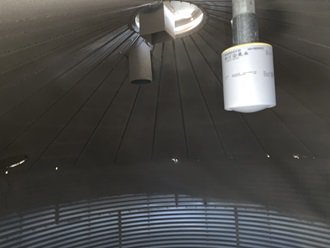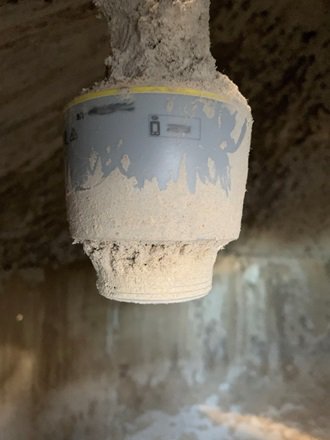Making grain processing safer with radar level measurement
In Canada’s Alberta province, roughly two-thirds of the way between Edmonton and Calgary, you’ll find the rural community of Linden. Farmers first settled this small village in the mid-1930s. That agricultural tradition still holds true, but today, they’re embracing high-tech level measurement solutions to automate many of their processes.
Atom Automation, a software and automation designer focused on agribusiness, is one of the companies helping agricultural facilities in Linden automate their processes, and they’re using VEGA radar sensors with 80 GHz technology to measure level in grain bins and silos.
When level measurements were a very manual process
At a grain processing facility in Linden, employees manually measured and monitored level, climbing to the top of 50’ bins and 75’ silos to check grains with a tape measure. In a few rare instances, mechanical paddle switches provided high level alarms for filling control. Unfortunately, all these solutions were less than ideal.
In places without level measurement instrumentation, employees climbed to the top of these tall bins and silos – even in the harsh winters in Central Alberta – to track grain level. The task was time-consuming, and it poses a safety risk.
The high level alarm switches proved to be unreliable and difficult to operate. Employees regularly climbed the silos and bins to simply troubleshoot, maintain, and clean the few instruments they did have. They needed a maintenance-free solution they could count on to minimize or even eliminate the multiple trips to the top of the silo.
Better solutions with 80 GHz radar technology
Because of their previous experiences with automated solutions, the grain processing facility was hesitant to try another level measurement sensor, but VEGA and Atom Automation convinced the grain processing facility to try 80 GHz radar after discussing the technology’s benefits.
Radar level measurement sensors are a non-contact technology, which minimizes and oftentimes even eliminates any ongoing maintenance. The 80 GHz frequency ensures a more focused signal for a more reliable measurement, even in high dust environments frequently found in grain bins and silos. And since many agribusinesses operate on slim margins and tight budgets, the VEGAPULS C 20 series was priced just right for this operation.
A cost-effective radar sensor with Bluetooth connectivity
The VEGAPULS C 23 radar level sensor simply drops into the grain silo to make a non-contact level measurement using 80 GHz radar technology.
The VEGAPULS C 20 series offers different options for users, all of which are dependent on the application where they’re being used. For large grain bins and silos, the VEGAPULS C 21 and VEGAPULS C 23 were the sensible choice. Both sensors have several similarities and a few key differences.
The VEGAPULS C 21 and VEGAPULS C 23 sensors both use an 80 GHz transmission frequency and have PVDF housings with an attached axial cable. These radar sensors can be configured with Class II Division 1, 2 approvals, an important requirement in grain bins and silos. Plus, any sensor in Alberta, Canada needs to be able to withstand harsh winter conditions, and both VEGAPULS radars can operate in conditions as cold as -40° C.
The biggest difference between the VEGAPULS C 21 and the VEGAPULS C 23 is their measuring ranges, 49 feet (15 meters) and 98 feet (30 meters), respectively. And while they both use an 80 GHz frequency with exceptional signal focus, they each have slightly different beam angles. These small differences and a difference in price meant using both types of sensors would provide the most cost-effective level measurements the grain processing facility needed.
The grain processing facility and Atom Automation installed the VEGAPULS C 21 radar sensors on the smaller grain bins, and they mounted the VEGAPULS C 23 radar sensors on the taller silos. Installation on top of the bins and silos proved to be simple, and operators easily set up and adjusted every sensor with a wireless Bluetooth connection and the VEGA Tools app.
Employees no longer need to climb each individual bin and silo for measurements. Every measurement can now be viewed with feet firmly planted on the ground – either through their control system or easily accessed with any smart device using the VEGA Tools app with a secure Bluetooth connection.
Better measurements and more
Grain dust quickly builds up on the VEGAPULS C 21 radar level sensor after just a few months in use, but the radar continues to output reliable and accurate measurements because of intelligent software within.
The radar sensors are outputting reliable measurements, even during filling and emptying cycles when dust is prevalent. Over the past few months, some of that dust has stuck to the radar sensors’ antennas, but employees haven’t needed to service or clean any of the new sensors. That’s because they’re still receiving accurate measurements through the buildup thanks to intelligent electronics within each VEGAPULS radar sensor that ignores any buildup on the antenna.
In addition to safer, more accurate, and reliable real-time measurements, the newly installed VEGAPULS C 21 and VEGAPULS C 23 radar sensors brought about some unexpected benefits as well. Operation efficiency has improved greatly. The facility is maximizing vessel use, filling up some bins and silos with as much as 20 percent more product. Plus, they’ve been able to optimize their trucking logistics and inventories. Overall, the VEGAPULS C 21 and VEGAPULS C 23 radar sensors have improved this grain facility’s operation in more ways than one.
Related products
Export this article
Download as PDFShare this article
Comments ({{comments.length}})
{{getCommentAuthor(comment, "Anonymous")}} {{comment.timestamp | date : "dd.MM.yyyy HH:mm" }}
{{comment.comment}}







